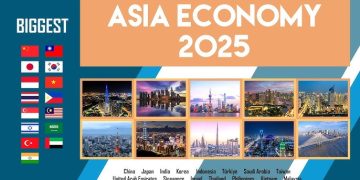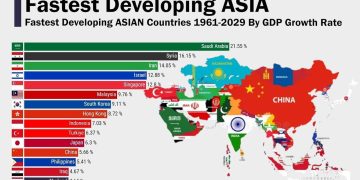Introduction: Entering an Age of Structural Slowdown
The global economy has entered a period marked not by cyclical slowdown but by what many economists now call structural low growth. Over the past decade, productivity has decelerated, demographic changes have tightened labor markets, geopolitical tensions have inhibited cooperation, and debt levels have soared across advanced and emerging markets alike. The result is an international financial landscape defined not by synchronized expansion—as seen in the 2000s and the post–Global Financial Crisis rebound—but by deep divergence, persistent uncertainty, and competing monetary and geopolitical blocs.
This new era of fragmentation is reshaping capital flows, currency dynamics, central bank strategies, and investment patterns. In 2025, projections from major financial institutions consistently point to global GDP growth stabilizing around 3.0%—below the long-term average of 3.8% before 2010, and significantly below the 4.5%–5.0% seen between 2000 and 2007. More importantly, this slowdown is uneven: the United States displays surprising resilience fueled by technology-driven productivity, while Europe wrestles with stagnation, and several emerging markets experience both high growth potential and elevated financial vulnerability.
Understanding how this low-growth, high-fragmentation world functions is now essential for investors, policymakers, and businesses. This article provides a comprehensive analysis of the forces behind global economic divergence, the implications for international finance, and the strategic adjustments required to navigate this new environment.
1. The Structural Forces Behind Global Low Growth
1.1 Declining Global Productivity
Productivity—the engine of long-term economic expansion—has slowed dramatically across advanced economies.
Several structural trends contribute to this decline:
- Aging populations reducing labor-force participation.
- Lower returns to technological innovation, despite rapid advancements in AI and automation.
- Insufficient investment in infrastructure and education in many economies.
- Reduced global trade openness, which historically amplified productivity gains through knowledge transfer and competition.
While the AI revolution promises to reverse this trend in the long run, its diffusion across industries remains slow and uneven.
1.2 Demographic Pressures and Workforce Transformation
The global demographic transition is creating a persistent drag on growth:
- Europe, Japan, South Korea, and China face shrinking working-age populations.
- The U.S. benefits slightly from immigration but still faces long-term aging.
- India, Southeast Asia, and parts of Africa remain demographic bright spots, yet struggle with underemployment and skill mismatches.
The result is a world in which labor is scarce in wealthy countries and overly abundant in poorer ones—an imbalance contributing to both wage inflation and social tension.
1.3 The Geopolitical Economy: Fragmentation Over Integration
The post–Cold War system of increasing global integration is giving way to a new era of geoeconomic competition:
- The U.S.–China technological and geopolitical rivalry.
- The weaponization of trade, investment, and financial sanctions.
- The reshoring and “de-risking” of supply chains.
- Regional trade blocs increasingly replacing global trade regimes.
This fragmentation disrupts long-standing assumptions about capital mobility and global economic policy coordination.
1.4 Inflation Persistence and Monetary Policy Reset
The inflation shock of the early 2020s forced central banks to raise interest rates aggressively.
Even as inflation moderated, structural pressures remain:
- Tight labor markets
- Supply-chain reconfiguration
- Persistent fiscal deficits
- Climate transition costs
This means interest rates may remain higher for longer, fundamentally altering global financing conditions.
1.5 The Global Debt Overhang
Public and private debt have reached record highs:
- Many advanced economies exceed 100% public-debt-to-GDP.
- Emerging markets face rising refinancing risks as U.S. rates remain elevated.
- Corporate debt has surged due to years of cheap money.
A highly leveraged world is fundamentally less capable of strong, sustained growth.
2. A World of Divergence: Growth Patterns and Regional Fragmentation
2.1 United States: Resilient, Innovative, but Uneven
Despite high interest rates, the U.S. economy remains surprisingly robust due to:
- Strong household balance sheets
- Persistent domestic consumption
- Rapid AI adoption in large corporations
- A globally dominant technology sector
- Flexible labor markets and immigration flows
However, inequality is widening, and public debt is a long-term risk.
2.2 Europe: Stagnation and Structural Decay
Europe is increasingly described as “the new Japan”:
- Chronic low productivity
- Energy insecurity after Russian supply disruptions
- Aging demographics
- Slow adoption of digital and AI technologies
- Fragmented fiscal policy across the EU
- Weak investment environment
These structural weaknesses hinder Europe’s ability to compete with the U.S. and China.
2.3 China: Transitioning From High-Speed to High-Quality Growth
China’s economy is undergoing a profound shift:
- The property sector slowdown
- The transition to advanced manufacturing and AI
- Slower population growth
- Geopolitical pressure on exports and technology
- Rising importance of domestic consumption
Growth is lower than in the past, but China remains one of the largest contributors to global expansion.
2.4 Emerging Markets: Opportunity and Vulnerability
Countries like India, Indonesia, Vietnam, and Mexico exhibit strong growth potential due to:
- Favorable demographics
- Lower production costs
- Supply-chain realignment
- Increasing domestic consumption
But emerging markets also face:
- Currency volatility
- High external debt
- Political uncertainty
- Climate-related vulnerabilities
This makes capital flows more sensitive and volatile.
3. Implications for International Capital Flows
3.1 Risk Repricing in a High-Rate World
The end of ultra-low interest rates has triggered a global repricing of risk:
- High-yield assets face greater stress.
- Investors prefer U.S. Treasuries and dollar assets.
- Equity valuations vary sharply across regions.
The global investment hierarchy is shifting toward quality, safety, and liquidity.
3.2 Fragmentation of Capital Markets
Geopolitical tensions have created separate or partially overlapping financial ecosystems:
- U.S.-aligned financial networks
- China-centered financial systems
- Regional alternative platforms (e.g., BRICS payment systems)
Sanctions, export controls, and technological blocks accelerate this realignment.
3.3 Emerging Market Capital Inflows: A Double-Edged Sword
Emerging markets continue to attract capital, especially in:
- Technology manufacturing
- Green energy
- Digital infrastructure
However, these same markets remain vulnerable to:
- Sudden stops
- Dollar appreciation cycles
- Changes in global risk appetite
This reinforces the need for prudent macroeconomic management.

4. Currency Dynamics in a Fragmented Global Economy
4.1 The Resilient Dollar
Despite predictions of “de-dollarization,” the U.S. dollar remains dominant due to:
- Deep, liquid capital markets
- Strong institutions
- Safe-haven demand
- Leadership in AI and technology
As long as global fragmentation persists, the dollar is likely to strengthen.
4.2 The Euro Under Pressure
Europe’s currency faces structural challenges:
- Weak growth
- Lack of fiscal union
- Dependence on energy imports
- Geopolitical exposure
Though stable, the euro lacks the structural advantages of the dollar.
4.3 The Yuan: Gradual, Strategic Internationalization
China is pushing for greater use of the renminbi in trade and reserves:
- Expanded use in energy trade
- Strengthening of CIPS as an alternative to SWIFT
- Promotion of digital yuan cross-border usage
However, capital controls and trust issues limit rapid progress.
4.4 Currency Multipolarity: Slow but Steady
The future will likely see:
- A dollar-centered system
- A growing, but limited role for the yuan
- Regional currencies gaining niche relevance
True multipolarity will develop gradually over decades.
5. Sovereign Debt, Fiscal Stress, and Financial Stability Risks
5.1 Advanced Economies Face Rising Fiscal Challenges
The U.S., Japan, and EU have reached dangerous levels of public debt.
Large deficits are now structural due to:
- Aging populations
- Healthcare and pension costs
- Industrial subsidies
- Military spending increases
Higher interest rates make debt servicing increasingly burdensome.
5.2 Emerging Market Debt Risks
Many EMs face refinancing risks in:
- Dollar-denominated bonds
- Short-term sovereign debt
- High-yield corporate obligations
Countries without credible fiscal frameworks risk crises similar to Argentina or Sri Lanka.
5.3 Banking Sector Vulnerabilities
High interest rates have weakened balance sheets:
- Mark-to-market losses on bonds
- Commercial real estate risks
- Funding pressures on regional banks
Banks in Europe and the U.S. remain resilient but not immune.
6. Policy Responses: Central Banks and Governments in a New Era
6.1 Central Banks Balancing Inflation and Stability
Key strategies include:
- Maintaining higher rates for longer
- Quantitative tightening cycles
- Prudential regulation to reduce systemic risk
- New liquidity backstops for financial stability
Coordinated global action remains limited.
6.2 Industrial Policy Resurgence
Governments increasingly adopt industrial strategies:
- U.S. CHIPS and IRA
- China’s strategic manufacturing and AI push
- EU’s Green Deal industrial program
This shift affects global trade and investment patterns.
6.3 Selective Global Cooperation
Despite fragmentation, cooperation persists in:
- Climate finance
- Financial stability frameworks (IMF, G20)
- Technology standards
- Pandemic and global health initiatives
But trust deficits limit deeper collaboration.
7. Strategic Implications for Investors, Firms, and Policymakers
7.1 For Investors
- Prioritize quality fixed-income assets (U.S. Treasuries, investment-grade bonds).
- Increase exposure to emerging markets with strong fundamentals (India, Indonesia, Mexico).
- Diversify currency risk.
- Monitor geopolitical triggers that may cause sudden volatility.
7.2 For Multinational Corporations
- Build supply-chain resilience across multiple regions.
- Incorporate geopolitical risk assessment into investment plans.
- Increase automation and AI adoption to compensate for labor shortages.
- Strengthen currency risk hedging strategies.
7.3 For Policymakers
- Enhance fiscal discipline and long-term sustainability.
- Improve monetary-fiscal coordination.
- Support innovation, education, and talent development.
- Facilitate cross-border financial stability cooperation.
Conclusion: Navigating a Fragmented, Low-Growth World
The global economy is undergoing one of the most profound transformations of the past half-century. The era of high growth, deep integration, and low interest rates has ended. What emerges in its place is a world defined by structural stagnation, demographic headwinds, geopolitical fragmentation, and rising financial vulnerabilities.
Yet within this challenging environment lie significant opportunities—particularly for countries and companies able to innovate, adapt, and position themselves at the center of emerging technological and economic networks. As global finance transitions into this new paradigm, agility, diversification, and strategic foresight will determine who thrives and who falls behind.
































